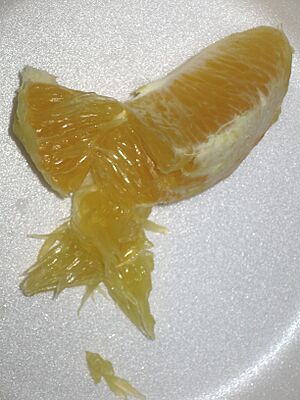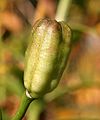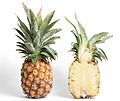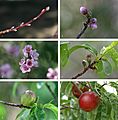Pulp (fruit) facts for kids

The pulp of a citrus fruit is the soft, juicy part inside. It's the stringy stuff you find when you open up fruits like oranges or grapefruits. This part holds all the delicious juice!
When you drink fruit juice, the pulp is often taken out. This is done by filtering the juice to make it smooth.
The color of the pulp can be different. It depends on the type of fruit and how ripe it is. Usually, the pulp is the same color as the fruit's skin.
How juicy the pulp is also changes. It depends on the fruit's species (its kind) and its variety. Even the season and the specific tree it grew on can affect how much juice the pulp has.
Contents
What is Fruit Pulp?
Fruit pulp is the soft, fleshy part inside many fruits. It's what you eat in an orange or a mango. This part is full of water and nutrients. It's also where the fruit's juice is stored.
Where is Pulp Found?
Pulp is found in the inner layer of a fruit, called the endocarp. Think of it as the core of the fruit that holds the seeds and the juice. In citrus fruits, the endocarp is divided into segments, and each segment is filled with tiny sacs of pulp.
Why is Pulp Removed from Juice?
Sometimes, people prefer their fruit juice to be very smooth. Because of this, the pulp is often filtered out. This makes the juice clear and easy to drink without any chewy bits.
Pulp Characteristics
The pulp of a fruit has different features. These can change depending on the fruit.
Pulp Color
The color of the pulp is not always the same. It can vary based on the species of fruit. For example, oranges have orange pulp, while some grapefruits have pink or red pulp. The color also changes as the fruit gets more ripe.
Pulp Juiciness
Some fruits have very juicy pulp, while others are drier. This depends on many things. The variety of the fruit plays a big role. The season when the fruit grows also affects how juicy it is. Even the specific tree can make a difference in the pulp's juiciness.
Related pages
Images for kids
-
Various culinary fruits
-
Caraway fruits. A common mistake is to call these and similar ones "seeds".
-
Pomegranate display of the exocarp (right) and seeds and edible sarcotesta (left)
-
An arrangement of fruits commonly thought of as culinary vegetables, including corn (maize), tomatoes, and various squash
-
Dewberry flowers. Note the multiple pistils, each of which will produce a drupelet. Each flower will become a blackberry-like aggregate fruit.
-
A dry simple fruit: milkweed (Asclepias syriaca); dehiscence of the follicular fruit reveals seeds within.
-
Strawberry, showing achenes attached to surface. Botanically, strawberries are not berries; they are classified as an aggregate accessory fruit.
-
Flower of Magnolia × wieseneri showing the many pistils making up the gynoecium in the middle of the flower. The fruit of this flower is an aggregation of follicles.
-
Detail of the raspberry flower: there is a clustering of pistils at the center of the flower. (A pistil consists of stigma, style, and ovary.) The stigma is the apical (at the apex) nodule that receives pollen; the style is the stem-like column that extends down to the ovary, which is the basal part that contains the seed-forming ovule.
-
Lilium unripe capsule fruit; an aggregate fruit.
-
The fruit of a pineapple includes tissue from the sepals as well as the pistils of many flowers. It is a multiple-accessory fruit.
-
Comparing fresh fruits for fiber, potassium (K), and vitamin C. Each disk-point refers to a 100 g serving of the fresh fruit named. The size of the disk represents the amount of fiber (as percentage of the recommended daily allowance, RDA) in a serving of fruit (see key at upper right). The amount of vitamin C (as percent RDA) is plotted on the x–axis and the amount of potassium (K), in mg on the y–axis. + Bananas are high in value for fiber and potassium, and oranges for fiber and vitamin C. (Apricots are highest in potassium; strawberries are rich in vitamin C.) Watermelon, providing low levels of both K and vitamin C and almost no fiber, is of least value for the three nutrients together.
-
Porcelain vine is usually planted for its showy, colourful berries.
-
In the noni, flowers are produced in time-sequence along the stem. It is possible to see a progression of flowering, fruit development, and fruit ripening.
See also
 In Spanish: Fruto para niños
In Spanish: Fruto para niños



















